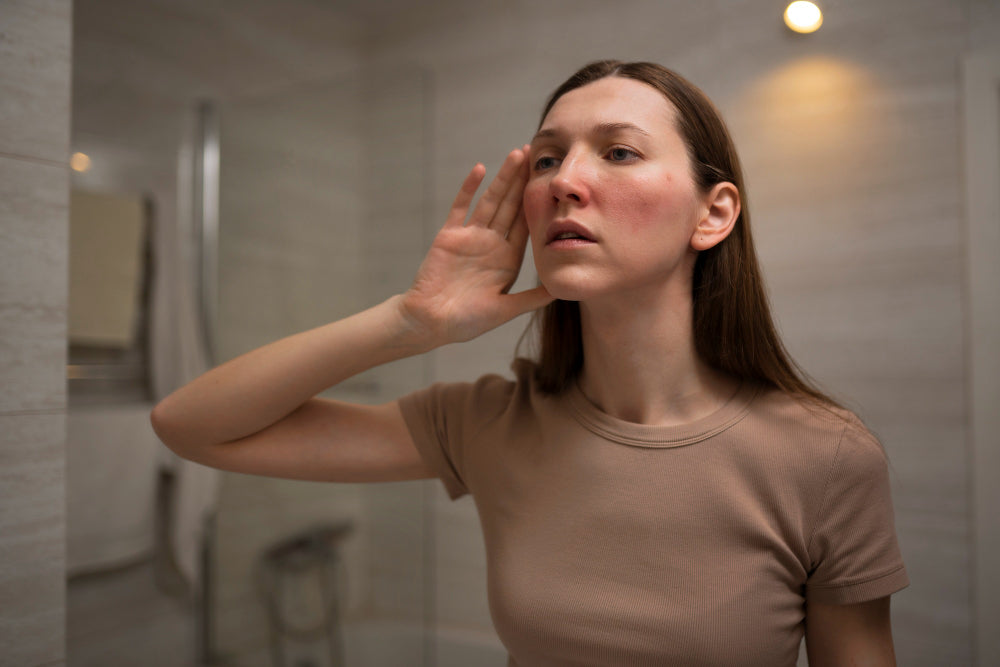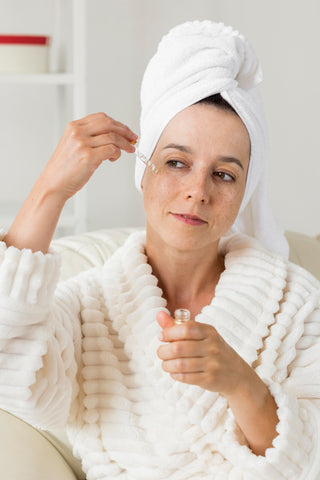Retinol Burn: Causes, Treatment and More


Retinol, a derivative of vitamin A, has gained prominence for its efficacious role in skin renewal and anti-ageing. Utilised in various skincare formulations, it contributes to enhancing skin texture and mitigating signs of ageing. However, the potent nature of retinol has led to a prevalent concern known as retinol burn, characterised by skin irritation and damage resulting from its use. Addressing retinol burn is crucial, given its impact on skin health and the increasing incorporation of retinol in skincare regimens.
Retinol burn refers to the adverse reaction of the skin to retinol, manifesting as irritation, dryness, and peeling. This condition is not a burn in the traditional sense but resembles one due to the similarity in symptoms. It results from the skin's inability to tolerate the intensity of retinol, leading to a compromised skin barrier.
The primary symptoms include redness, irritation, peeling, and an increased sensitivity to touch and sunlight. Dr. Amanda Smith, a dermatologist, notes, "Patients often report a stinging sensation followed by visible peeling and redness, akin to sunburn, indicating a reaction to retinol." Such symptoms can compromise the skin's integrity, highlighting the necessity for careful retinol use.
Understanding the causes of retinol burn is crucial for anyone looking to incorporate this potent ingredient into their skincare routine safely. Retinol burn often results from over-application, starting with too high a concentration, combining retinol with other harsh skincare ingredients, or neglecting individual skin sensitivities and environmental factors. By familiarizing oneself with these common triggers, users can navigate the use of retinol more effectively, avoiding irritation and ensuring a positive impact on skin health. This section delves into each cause, offering insight into how to prevent retinol burn while harnessing the benefits of this transformative skincare component.
The frequency and quantity of retinol application play a significant role in the occurrence of retinol burn. Excessive use, especially without prior acclimatisation, can overwhelm the skin, leading to irritation. According to a study published in the Journal of Clinical and Aesthetic Dermatology, a significant percentage of retinol-related skin issues arise from over-application or high-frequency use.
The initiation of high-strength retinol without allowing the skin to adjust gradually can precipitate retinol burn. Dr. Smith advises, "Starting with a lower concentration and progressively increasing the strength allows the skin to build tolerance, mitigating the risk of irritation."
The concurrent use of retinol with other potent ingredients like alpha-hydroxy acids (AHAs), beta-hydroxy acids (BHAs), and vitamin C can exacerbate skin sensitivity and irritation. This is attributed to the cumulative exfoliative effects, which can strip the skin of its natural oils and protective barrier.
External elements such as exposure to sunlight and pollution, coupled with inherent skin sensitivity, can influence the likelihood of developing retinol burn. Dr. Emily White, a researcher in dermatological sciences, suggests, "Individual skin type and environmental factors significantly affect the skin's reaction to retinol, necessitating a tailored approach to its use."
Preventing retinol burn is essential for those integrating this potent ingredient into their skincare regimen. By understanding the proper application techniques, starting with lower concentrations, and recognizing the importance of a gradual introduction, users can minimize the risk of irritation and enjoy the benefits of retinol without compromising skin health. This guide outlines the crucial steps and considerations to safely incorporate retinol into your routine, ensuring a positive and effective skincare experience.
Patch testing is a critical step before incorporating new retinol products into a skincare regimen. This process helps identify potential adverse reactions, ensuring compatibility with the skin. Dr. Smith emphasises, "Patch testing can avert severe skin reactions, serving as a precautionary measure."
Gradually introducing retinol, beginning with a low concentration, is essential for minimising the risk of retinol burn. This strategy allows the skin to adapt to retinol's effects, reducing the likelihood of irritation.
Layering skincare products correctly and spacing out the use of retinol can prevent the overburdening of the skin. It is advisable to allow ample time for the skin to absorb retinol before applying other products, particularly those with active ingredients.
The application of sunscreen is imperative when using retinol, given the increased photosensitivity it induces. Dr. White states, "Sunscreen not only protects against UV damage but also prevents the exacerbation of retinol-induced sensitivity, safeguarding the skin's health."
When encountering symptoms indicative of retinol burn, certain measures should be promptly undertaken to mitigate the adverse effects and facilitate skin recovery.
The immediate cessation of retinol use is paramount upon noticing symptoms such as redness, peeling, or irritation. Dr. Lisa Patel, a dermatology specialist, advises, "Halting the application of retinol is crucial to prevent further aggravation of the skin."
Adopting a gentle skincare routine focused on hydration and barrier repair is essential during this period. Utilising products that are free from irritants such as fragrances and alcohol can provide the skin with the necessary conditions to heal.
Products containing ceramides, hyaluronic acid, and panthenol are highly recommended for their roles in soothing and repairing the skin. Ceramides aid in restoring the skin's barrier, hyaluronic acid provides intense hydration, and panthenol promotes healing. "These ingredients are key in accelerating recovery from retinol burn by nurturing the skin's protective barrier," mentions Dr. Patel.
It is critical to recognise the signs of severe skin reactions that necessitate professional intervention. Persistent severe redness, blistering, or infection are indicators that a dermatologist's expertise is required. Dr. Patel adds, "Professional guidance can prevent complications and provide targeted treatments for retinol burn."
Reintroducing retinol post-burn involves a cautious and patient approach to prevent recurrence of irritation.
Starting with a minimal concentration and limiting application to once or twice a week allows the skin to gradually acclimate to retinol again. Dr. Patel suggests, "Monitoring the skin's response and adjusting the frequency of application based on tolerance is vital for safe reintroduction."
For individuals with sensitive skin, exploring alternative retinol products, such as retinol esters or retinaldehyde, might prove beneficial. These derivatives are milder yet still effective in delivering the anti-ageing benefits of retinol without the harshness.
Maintaining a balanced skincare routine that supports skin health is essential when using retinol. This includes incorporating nourishing and protective products to complement the effects of retinol and safeguard the skin.

The duration of retinol burns can vary depending on the severity of the reaction and the individual's skin type. Generally, mild retinol burns may last a few days to a week, whereas more severe reactions could take up to two weeks or longer to heal completely. It is crucial to cease using retinol and adopt a gentle skincare routine to aid in the skin's recovery process during this period.
Fixing a retinol burn involves several key steps:
If retinol dries out your skin, consider the following measures:
Signs that you might be allergic to retinol include:
If you suspect you're allergic to retinol, it's imperative to:
Recognising the difference between typical retinol irritation and an allergic reaction is crucial for the health and safety of your skin. An allergy to retinol, while less common than irritation, requires immediate attention and adjustments to your skincare regimen to avoid further skin damage.
The use of retinol in skincare regimens necessitates a comprehensive understanding of its potential side effects, such as retinol burn. Implementing preventative measures, recognising symptoms, and understanding treatment options are crucial steps in mitigating the risks associated with retinol use. By adhering to guidelines for safe application and incorporating suitable products, individuals can harness the benefits of retinol while maintaining skin health. Dr. Patel concludes, "Respecting the potency of retinol and listening to the skin's needs are fundamental in achieving desired outcomes without compromising skin integrity."










Plus get the inside scoop on our latest content and updates in our monthly newsletter.